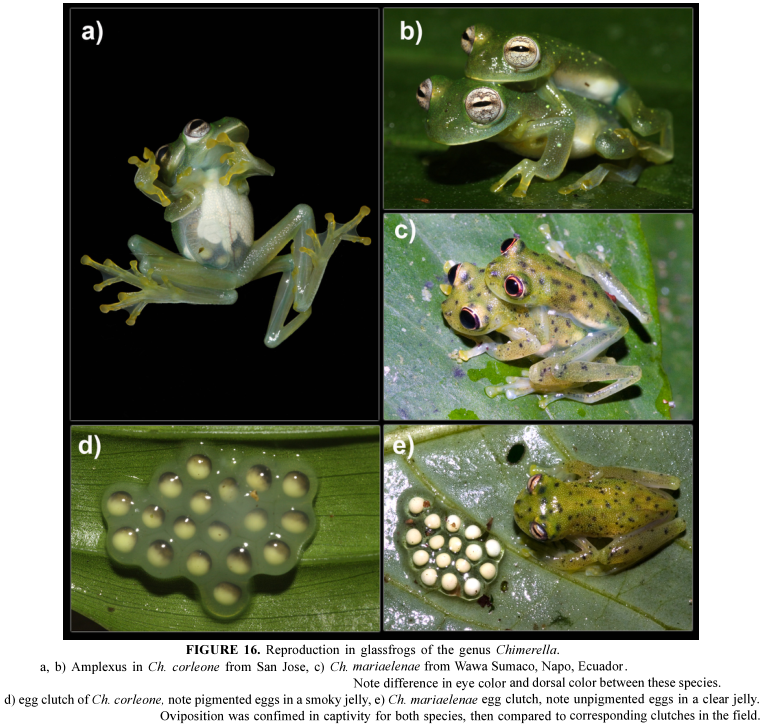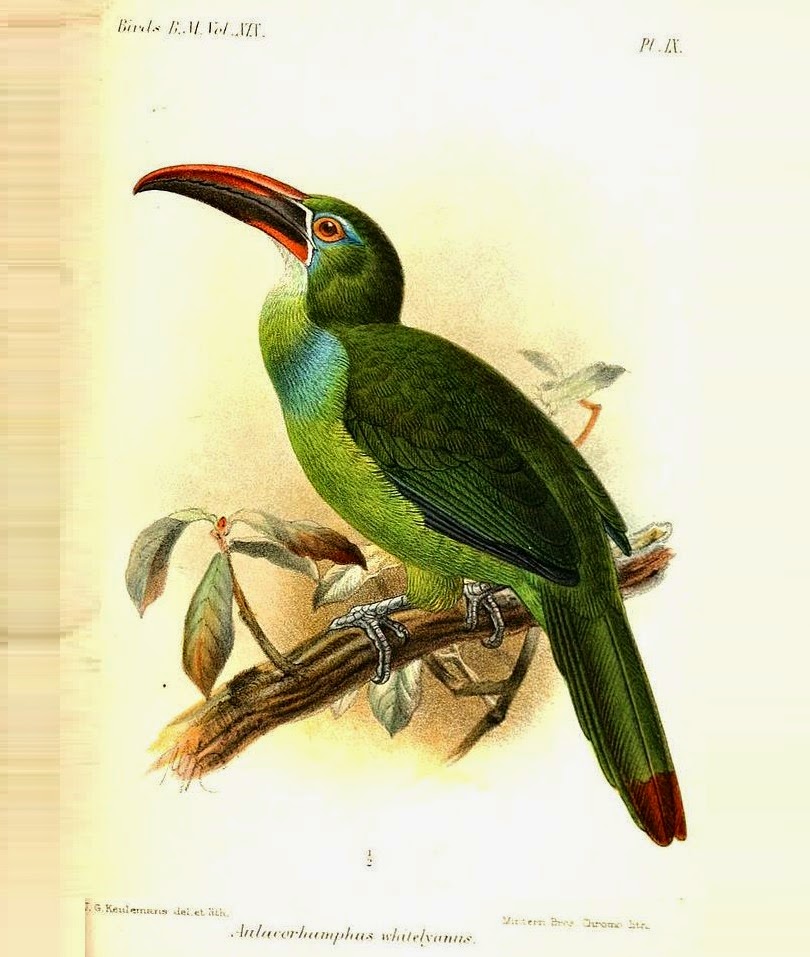[Most Recent Entries] [Calendar View]
Thursday, August 14th, 2014
| Time | Event | ||||||||
| 5:11a | [Herpetology • 2014] A Review of Northern Peruvian Glassfrogs (Centrolenidae), with the Description of Four New Remarkable Species
ABSTRACT Peru is well known for amphibian diversity and endemism, yet there have been relatively few field studies of glassfrog (Centrolenidae) diversity in this country. Research in Colombia and Ecuador indicates that centrolenid diversity is higher in the northern Andes. However, part of this trend appears to be due to sampling effort. We conducted fieldwork throughout northern Peru, and based on phylogenetic analysis of DNA sequences, combined with bioacoustic and morphological analyses of new and available material we now recognize 33 species from the country (versus 30 species prior to this work). Field surveys led to the discovery of four remarkable species: Centrolene charapita new species is a large, ornamented glassfrog that appears to be sister to Ce. geckoideum; Chimerella corleone new species represents the second- known member of the genus Chimerella; Cochranella guayasamini new species is the second-known member of the genus with humeral spines; and Hyalinobatrachium anachoretus new species occurs in the cloud forest of the east-Andean versant in Peru. In addition to the new species described here, we provide new country records, new localities including range extensions of up to 875 km, information on diagnostic characters and phylogenetic relationships, call and larval descriptions, and observations on natural history for several Peruvian centrolenids. Our results also revealed several taxonomic problems concerning species of the genus Rulyrana, and we conclude that R. croceopodes and R. tangarana are junior synonyms of R. saxiscandens. By implication of our phylogenetic analyses, we recognize the following new com- binations: Espadarana audax new combination, Espadarana durrelorum new combination, and Espadarana fernandoi new combination. Keywords: Amphibians, Bioacoustics, Biodiversity, Integrative taxonomy, New species, Phylogenetics, Peru
Evan Twomey, Jesse Delia and Santiago Castroviejo-Fisher. 2014. A Review of Northern Peruvian Glassfrogs (Centrolenidae), with the Description of Four New Remarkable Species. Zootaxa. 3851(1):1-87. DOI: dx.doi.org/10.11646/zootaxa.3851.1.1 | ||||||||
| 5:56a | [Paleontology • 2014] Caiuajara dobruskii • Discovery of a Rare Pterosaur Bone Bed in a Cretaceous Desert with Insights on Ontogeny and Behavior of Flying Reptiles Abstract A pterosaur bone bed with at least 47 individuals (wing spans: 0.65–2.35 m) of a new species is reported from southern Brazil from an interdunal lake deposit of a Cretaceous desert, shedding new light on several biological aspects of those flying reptiles. The material represents a new pterosaur, Caiuajara dobruskii gen. et sp. nov., that is the southermost occurrence of the edentulous clade Tapejaridae (Tapejarinae, Pterodactyloidea) recovered so far. Caiuajara dobruskii differs from all other members of this clade in several cranial features, including the presence of a ventral sagittal bony expansion projected inside the nasoantorbital fenestra, which is formed by the premaxillae; and features of the lower jaw, like a marked rounded depression in the occlusal concavity of the dentary. Ontogenetic variation of Caiuajara dobruskii is mainly reflected in the size and inclination of the premaxillary crest, changing from small and inclined (~115°) in juveniles to large and steep (~90°) in adults. No particular ontogenetic features are observed in postcranial elements. The available information suggests that this species was gregarious, living in colonies, and most likely precocial, being able to fly at a very young age, which might have been a general trend for at least derived pterosaurs. Systematic Paleontology Pterosauria Kaup, 1834 Pterodactyloidea Plieninger, 1901 Azhdarchoidea Nessov, 1984 Tapejaridae Kellner, 1989 Tapejarinae Kellner, 1989 sensu Kellner & Campos Caiuajara dobruskii gen. et sp. nov. Etymology: Combination of Caiuá and Tapejara, the internal specifier of the Tapejarinae; species honors Alexandre Dobruski, who with his son, João Dobruski, found the new site back in 1971. Type locality, horizon and age: Cruzeiro do Oeste, Paraná State, Brazil; Bauru Basin, Caiuá Group, Goio-Erê Formation, Upper Cretaceous Paulo C. Manzig, Alexander W. A. Kellner, Luiz C. Weinschütz, Carlos E. Fragoso, Cristina S. Vega, Gilson B. Guimarães, Luiz C. Godoy, Antonio Liccardo, João H. Z. Ricetti and Camila C. de Moura. 2014. Discovery of a Rare Pterosaur Bone Bed in a Cretaceous Desert with Insights on Ontogeny and Behavior of Flying Reptiles. PLOS ONE. 9(8): e100005. doi: 10.1371/journal.pone.0100005 Bones from nearly 50 ancient flying reptiles discovered A stash of buried bones in Brazil has allowed scientists to identify a new species of flying dinosaur that soared in the skies 66 to 100 million years ago, a study said Wednesday. New Flying Reptile Found in"Unprecedented" Pterosaur Boneyard Forty-seven pterosaur skeletons unearthed at Brazilian site http://on.natgeo.com/1r9D7uu via @NatGeo | ||||||||
| 5:05p | [BioGeography / Ornithology • 2013] On the Origin of Pantepui Montane Biotas: A Perspective Based on the Phylogeny of Aulacorhynchus toucanets
ABSTRACT To understand the origin of Pantepui montane biotas, we studied the biogeography of toucanets in the genus Aulacorhynchus. These birds are ideal for analyzing historical relationships among Neotropical montane regions, given their geographic distribution from Mexico south to Bolivia, including northern Venezuela (Cordillera de la Costa), and the Pantepui. Analyses were based on molecular phylogenies using mitochondrial and nuclear DNA sequences. Topology tests were applied to compare alternative hypotheses that may explain the current distribution of Aulacorhynchus toucanets, in the context of previous hypotheses of the origin of Pantepui montane biotas. Biogeographic reconstructions in RASP and Lagrange were used to estimate the ancestral area of the genus, and an analysis in BEAST was used to estimate a time framework for its diversification. A sister relationship between the Pantepui and Andes+Cordillera de la Costa was significantly more likely than topologies indicating other hypothesis for the origin of Pantepui populations. The Andes was inferred as the ancestral area for Aulacorhynchus, and the group has diversified since the late Miocene. The biogeographic patterns found herein, in which the Andes are the source for biotas of other regions, are consistent with those found for flowerpiercers and tanagers, and do not support the hypothesis of the geologically old Pantepui as a source of Neotropical montain diversity. Based on the high potential for cryptic speciation and isolation of Pantepui populations, we consider that phylogenetic studies of additional taxa are important from a conservation perspective. Elisa Bonaccorso and Juan M Guayasamin. 2013. On the Origin of Pantepui montane biotas: A Perspective Based on the Phylogeny of Aulacorhynchus toucanets. PLoS ONE. 8(6):e67321. DOI: dx.doi.org/10.1371/journal.pone.0067321 |
| << Previous Day |
2014/08/14 [Calendar] |
Next Day >> |









